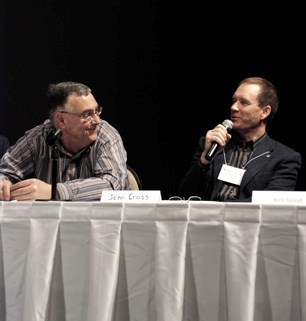If practices do not change, Alberta could be a net importer of food by 2055.
This was the stern warning Action for Agriculture (AA), a lobby group of Alberta farmers and ranchers, presented at a summit in Cochrane on Feb. 15.
AA hosted the event to outline their concerns regarding growth, loss of quality farmland, diminishing water supply and the impact these issues will have on the province moving forward.
The net result could be within the next 40 years Alberta won’t be able to produce enough food for its own residents.
The prediction was not just a means to garner attention, it is a distinct possibility, said rancher Gloria Wilkinson, a member of AA.
“How do we get the general population to understand we have to avoid this possibility?” said Wilkinson. “We have to consciously say it starts with me, what can I do?
“We have opened the door and are saying here we go, if we don’t do something we are in for a rough ride.”
At the Cochrane summit, which included representatives from the agriculture industry, the provincial government, media and municipal councillors, AA unveiled its video “Food for Thought,” outlining their concerns.
In 2010, the group spearheaded a cumulative effects study to understand the economic value of the ecosystem in the Upper Bow River Basin in southwest Alberta.
In October 2012, a group of 10 farmers and ranchers discussed the results of the study and the impact it will have on the agriculture industry.
The video is a synopsis of their conversation as well as results of the study done by landscape ecologist Dr. Brad Stelfox of Alces Group.
Stelfox said the results of the study speak for themselves.
“If the population continues to grow and we continue to erode these agricultural land bases we will become a net food importer by 2055,” said Stelfox.
Rancher and former Rocky View County councillor Harvey Buckley said this is a critical time for agriculture in the Bow River Basin.
“This story is about our land, about the importance of our land, about food security and about management of the land that sustains us,” said Buckley.
Foothills MD Councillor Suzanne Oel said she is not convinced there is a food crisis, but the issue is certainly worth discussion.
“I am not an alarmist,” said Oel, who attended the summit. “I do believe there is an issue ... but we are resilient, when there is a challenge in front of us, we meet it head-on and find a solution.”
Oel said the presentation by AA was an opportunity to engage the public and spark a discussion on land use and planning.
“It is helpful to get this information to help people to understand why we have to plan,” she said. “We have to learn from the mistakes of others so we do not go there.”
The video outlined Alberta’s growth over the last century and also promoted a new term called Natural Capital. Natural Capital is defined as ecological goods and services — land, air, water — and AA wants to put a monetary value on these goods and services to emphasis there is a cost to development.
Stelfox said Alberta’s economy is based on natural resources and a thriving economy comes at a cost: reduction of quality soils, water quality and supply, native grassland and biodiversity.
However, Stelfox said the issue is convincing average residents there is indeed a monetary cost to Alberta’s landscape.
AA hopes Natural Capital will become the new catch phrase and Albertans will start talking about the cost of growth.
“If we are talking about ecological goods and services in a monetary sense we have to put a dollar figure on it,” said Stelfox.
According to the Alces study if Alberta continues on its current pace there will be a Natural Capital liability of ecological goods and services of more than $550 million in the Bow River Basin alone.
Stelfox said that can be reduced to $300 million.
In an effort to slow the growth rate, Stelfox said it is essential Albertans get away from “business as usual” and enact “Best Management Practices.” According to Stelfox, that means cities growing up not out, nodal development in rural areas and protecting riparian areas.
He added there needs to be discussion on how to financially reward landowners who adopt best management practices.
Rancher John Cross said he was not surprised with some of the information revealed at the summit. “We got some choices to make,” said Cross, president of the Southern Alberta Land Trust (SALT). “I don’t think we will run out of food. We are going to get creative like Calgarians growing gardens instead of lawns.
“We are at a critical juncture,” he added. “We have an opportunity to make a decision now.”
For more information, visit www.actionforagriculture.com



